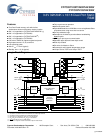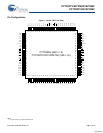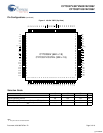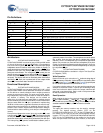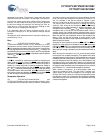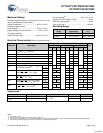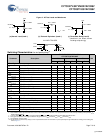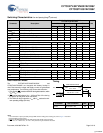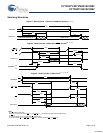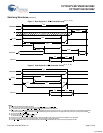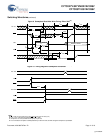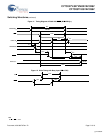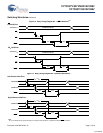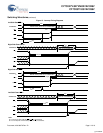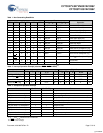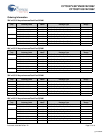
CY7C027V/027VN/027AV/028V
CY7C037V/037AV/038V
Document #: 38-06078 Rev. *B Page 5 of 18
generated to the owner. The interrupt is reset when the owner
reads the contents of the mailbox. The message is user defined.
Each port can read the other port’s mailbox without resetting the
interrupt. The active state of the busy signal (to a port) prevents
the port from setting the interrupt to the winning port. Also, an
active busy to a port prevents that port from reading its own
mailbox and, thus, resetting the interrupt to it.
If an application does not require message passing, do not
connect the interrupt pin to the processor’s interrupt request
input pin.
The operation of the interrupts and their interaction with Busy are
summarized in Ta b le 2 .
Busy
The CY7C027V/027VN/027AV/028V and
CY7037V/037AV/038V provide on-chip arbitration to resolve
simultaneous memory location access (contention). If both ports’
CE
s are asserted and an address match occurs within t
PS
of each other,
the busy logic determines which port has access. If t
PS
is violated, one
port definitely gains permission to the location, but it is not predictable
which port gets that permission. BUSY is asserted t
BLA
after an address
match or t
BLC
after CE is taken LOW.
Master/Slave
A M/S pin is provided to expand the word width by configuring the
device as either a master or a slave. The BUSY
output of the master is
connected to the BUSY
input of the slave. This allows the device to
interface to a master device with no external components. Writing to
slave devices must be delayed until after the BUSY
input has settled
(t
BLC
or t
BLA
), otherwise, the slave chip may begin a write cycle during
a contention situation. When tied HIGH, the M/S
pin allows the device
to be used as a master and, therefore, the BUSY
line is an output. BUSY
can then be used to send the arbitration outcome to a slave.
Semaphore Operation
The CY7C027V/027VN/027AV/028V and
CY7037V/037AV/038V provide eight semaphore latches, which
are separate from the dual-port memory locations. Semaphores
are used to reserve resources that are shared between the two
ports.The state of the semaphore indicates that a resource is in
use. For example, if the left port wants to request a given
resource, it sets a latch by writing a zero to a semaphore location.
The left port then verifies its success in setting the latch by
reading it. After writing to the semaphore, SEM
or OE must be
deasserted for t
SOP
before attempting to read the semaphore. The
semaphore value is available t
SWRD
+ t
DOE
after the rising edge of the
semaphore write. If the left port was successful (reads a zero), it
assumes control of the shared resource, otherwise (reads a one) it
assumes the right port has control and continues to poll the semaphore.
When the right side has relinquished control of the semaphore (by
writing a one), the left side succeeds in gaining control of the
semaphore. If the left side no longer requires the semaphore, a one is
written to cancel its request.
Semaphores are accessed by asserting SEM
LOW. The SEM pin
functions as a chip select for the semaphore latches (CE
must remain
HIGH during SEM
LOW). A
0–2
represents the semaphore address. OE
and R/W are used in the same manner as a normal memory access.
When writing or reading a semaphore, the other address pins have no
effect.
When writing to the semaphore, only I/O
0
is used. If a zero is written
to the left port of an available semaphore, a one appears at the same
semaphore address on the right port. That semaphore can now only be
modified by the side showing zero (the left port in this case). If the left
port now relinquishes control by writing a one to the semaphore, the
semaphore is set to one for both sides. However, if the right port had
requested the semaphore (written a zero) while the left port had control,
the right port would immediately own the semaphore as soon as the left
port released it. Ta bl e 3 shows sample semaphore operations.
When reading a semaphore, all sixteen/eighteen data lines
output the semaphore value. The read value is latched in an
output register to prevent the semaphore from changing state
during a write from the other port. If both ports attempt to access
the semaphore within t
SPS
of each other, the semaphore is definitely
obtained by one side or the other, but there is no guarantee which side
controls the semaphore.
[+] Feedback



